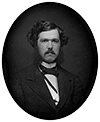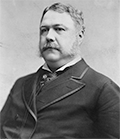Chester A. Arthur
Chester A. Arthur was a well-known lawyer, Vice-president, and then the 21st President of the United States. He was born on Oct. 5, 1829, in North Fairfield, Vt. One of eight children, he attended various schools because his family moved a few times during his childhood. He went to the Lyceum School and Union College, was a schoolteacher for awhile, and then graduated from the State and National Law School and won admittance to the bar in 1854. 
As a lawyer, Arthur won several well-known civil rights cases. He was the lawyer for Elizabeth Jennings Graham, an African-American woman who successfully prosecuted a New York City streetcar for race-based discrimination. He also played a part in a case in which the New York Court of Appeals (the state's highest court) ruled that a group of eight slaves (six children and two adults) who were being transported through New York on the way from one "slave" state (one that allowed slavery) to another could be free because of their time in New York, which had outlawed slavery in 1799. (John Jay had represented the slaves in the District Court round of Lemmon v. New York; Arthur argued the case on appeal. (The outbreak of the Civil War prevented the Supreme Court from hearing an appeal, and the outcome of the war rendered the point moot.) Arthur married Ellen Herndon in 1859. They had two children together. He was in the New York state militia in 1858݆ and earned the rank of quartermaster general. He also became involved in politics, first in the Whig Party and then in the Republican Party. He served seven years as the collector of the Port of New York and then was chosen as Vice-president when James A. Garfield was elected President. Garfield died on Sept. 19, 1881, after being shot. The next day, Arthur was sworn in as President. 
The new President carried on his successor's plans to a certain extent, signing into law the Pendleton Act, a package of civil service reform that ended the practice of using patronage as a guiding principle in making appointments by creating the bipartisan Civil Service Commission. (Ironically, Arthur got his start in politics thanks to an association with political boss and U.S. Senator Roscoe Conkling (R-N.Y.). It was Garfield's predecessor, Rutherford B. Hayes, who had first targeted the patronage system, making an example of Arthur and others by taking their jobs away from them; Arthur was collector of the New York Port at the time.) He exercised his veto power on a law that tried to stop immigration of people from China but then found a compromise solution with Congress that became the Chinese Exclusion Act of 1882. He also vetoed the Rivers and Harbor Act, which contained many expenditures for "pet" projects; Congress overrode that veto. Arthur convinced Congress to increase funding for Native American education and also sought a change from awarding land to Native American tribes to an allotment system that favored individual Native Americans; the Dawes Act in 1887 did just that (but after Arthur had left the White House). His wife had died in 1880. Arthur opted not to run for re-election and retired from politics, returning to the law. He hid the fact that he was suffering from the kidney-targeting Bright's disease. He died on Nov. 18, 1886, of a stroke, at his New York home; he was 57. |
|
Social Studies for Kids
copyright 2002–2025
David White




